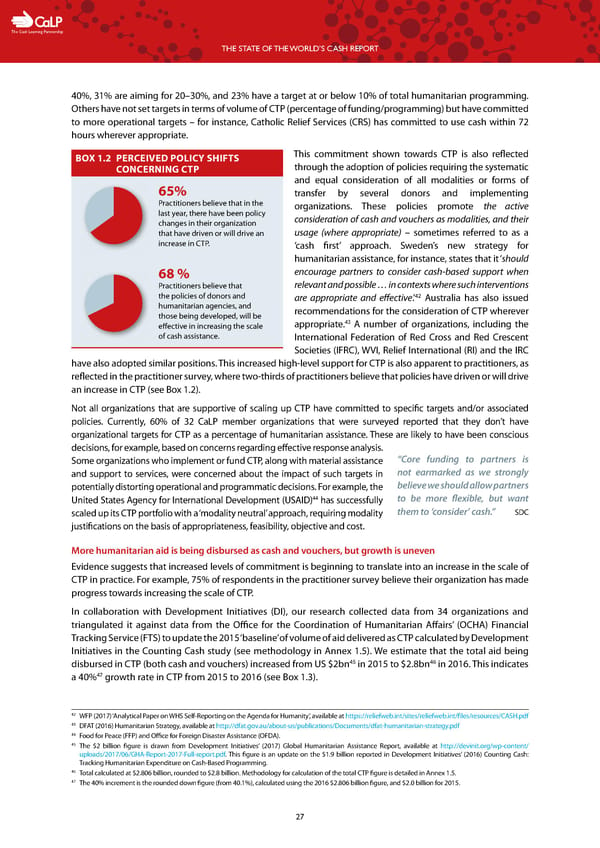C The Cash Learning Partnership THE STATE OF THE WORLD’S CASH REPORT 40%, 31% are aiming for 20–30%, and 23% have a target at or below 10% of total humanitarian programming. Others have not set targets in terms of volume of CTP (percentage of funding/programming) but have committed to more operational targets – for instance, Catholic Relief Services (CRS) has committed to use cash within 72 hours wherever appropriate. BOX 1.2 PERCEIVED POLICY SHIFTS This commitment shown towards CTP is also reflected CONCERNING CTP through the adoption of policies requiring the systematic 65% and equal consideration of all modalities or forms of transfer by several donors and implementing Practitioners believe that in the organizations. These policies promote the active last year, there have been policy consideration of cash and vouchers as modalities, and their changes in their organization that have driven or will drive an usage (where appropriate) – sometimes referred to as a increase in CTP. ‘cash first’ approach. Sweden’s new strategy for humanitarian assistance, for instance, states that it ‘should 68 % encourage partners to consider cash-based support when Practitioners believe that relevant and possible … in contexts where such interventions the policies of donors and 42 are appropriate and effective.’ Australia has also issued humanitarian agencies, and recommendations for the consideration of CTP wherever those being developed, will be effective in increasing the scale appropriate.43 A number of organizations, including the of cash assistance. International Federation of Red Cross and Red Crescent Societies (IFRC), WVI, Relief International (RI) and the IRC have also adopted similar positions. This increased high-level support for CTP is also apparent to practitioners, as reflected in the practitioner survey, where two-thirds of practitioners believe that policies have driven or will drive an increase in CTP (see Box 1.2). Not all organizations that are supportive of scaling up CTP have committed to specific targets and/or associated policies. Currently, 60% of 32 CaLP member organizations that were surveyed reported that they don’t have organizational targets for CTP as a percentage of humanitarian assistance. These are likely to have been conscious decisions, for example, based on concerns regarding effective response analysis. Some organizations who implement or fund CTP, along with material assistance “Core funding to partners is and support to services, were concerned about the impact of such targets in not earmarked as we strongly potentially distorting operational and programmatic decisions. For example, the believe we should allow partners 44 to be more flexible, but want United States Agency for International Development (USAID) has successfully scaled up its CTP portfolio with a ‘modality neutral’ approach, requiring modality them to ‘consider’ cash.” SDC justifications on the basis of appropriateness, feasibility, objective and cost. More humanitarian aid is being disbursed as cash and vouchers, but growth is uneven Evidence suggests that increased levels of commitment is beginning to translate into an increase in the scale of CTP in practice. For example, 75% of respondents in the practitioner survey believe their organization has made progress towards increasing the scale of CTP. In collaboration with Development Initiatives (DI), our research collected data from 34 organizations and triangulated it against data from the Office for the Coordination of Humanitarian Affairs’ (OCHA) Financial Tracking Service (FTS) to update the 2015 ‘baseline’ of volume of aid delivered as CTP calculated by Development Initiatives in the Counting Cash study (see methodology in Annex 1.5). We estimate that the total aid being disbursed in CTP (both cash and vouchers) increased from US $2bn45 46 in 2015 to $2.8bn in 2016. This indicates 47 a 40% growth rate in CTP from 2015 to 2016 (see Box 1.3). 42 WFP (2017) ‘Analytical Paper on WHS Self-Reporting on the Agenda for Humanity’, available at https://reliefweb.int/sites/reliefweb.int/files/resources/CASH.pdf 43 DFAT (2016) Humanitarian Strategy, available at http://dfat.gov.au/about-us/publications/Documents/dfat-humanitarian-strategy.pdf 44 Food for Peace (FFP) and Office for Foreign Disaster Assistance (OFDA). 45 The $2 billion figure is drawn from Development Initiatives’ (2017) Global Humanitarian Assistance Report, available at http://devinit.org/wp-content/ uploads/2017/06/GHA-Report-2017-Full-report.pdf. This figure is an update on the $1.9 billion reported in Development Initiatives’ (2016) Counting Cash: Tracking Humanitarian Expenditure on Cash-Based Programming. 46 Total calculated at $2.806 billion, rounded to $2.8 billion. Methodology for calculation of the total CTP figure is detailed in Annex 1.5. 47 The 40% increment is the rounded down figure (from 40.1%), calculated using the 2016 $2.806 billion figure, and $2.0 billion for 2015. 27
 The State of the World's Cash | Full Report Page 28 Page 30
The State of the World's Cash | Full Report Page 28 Page 30